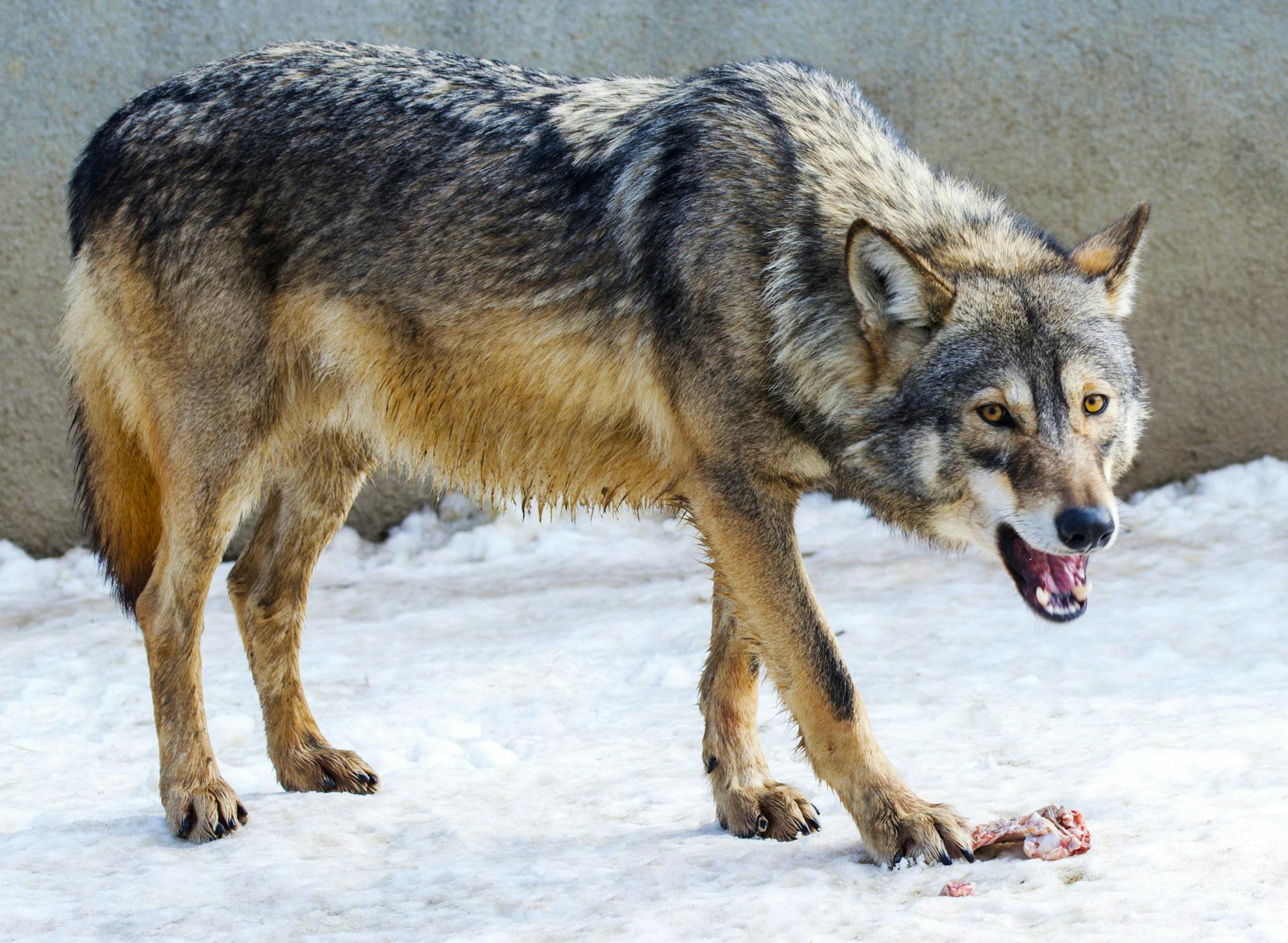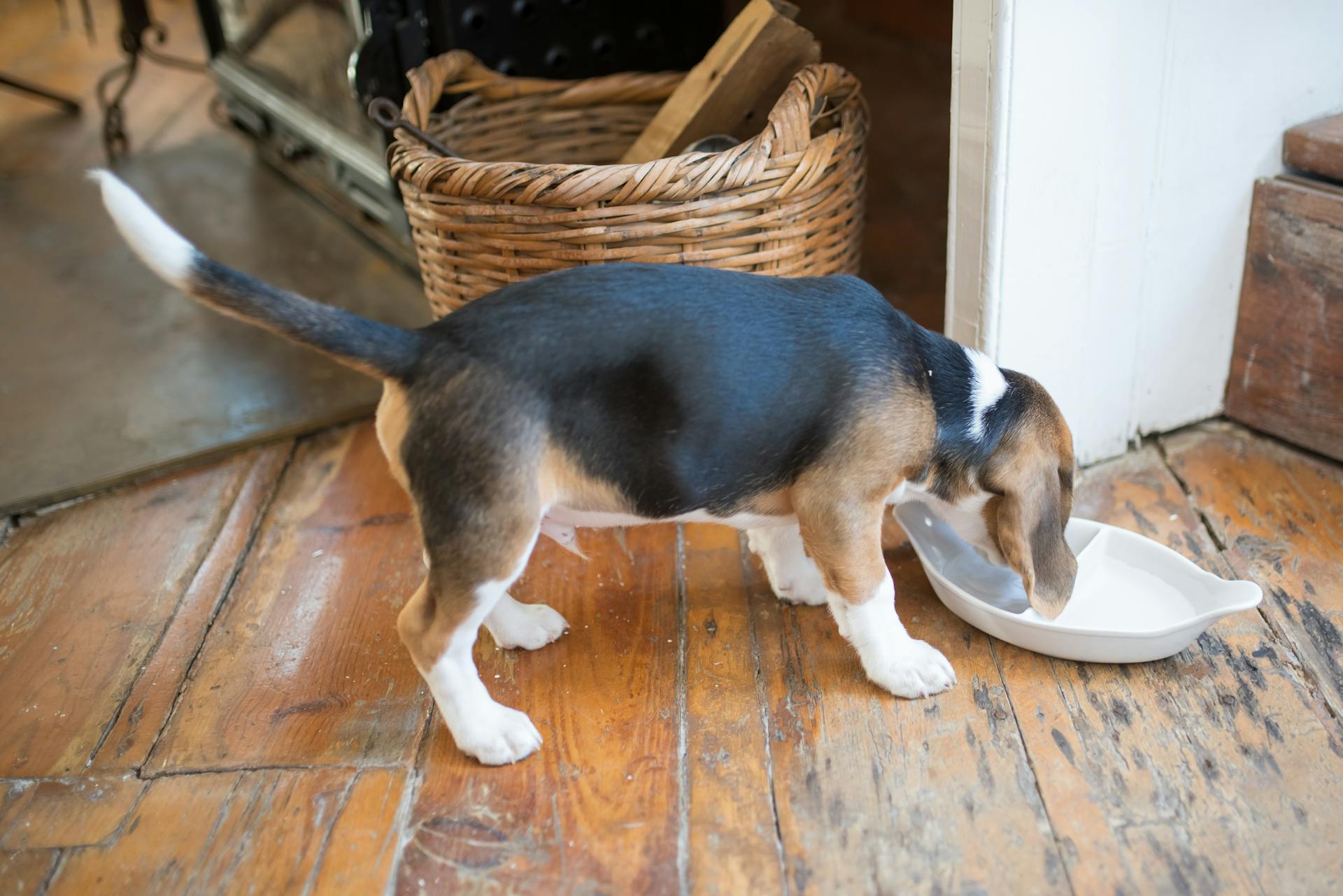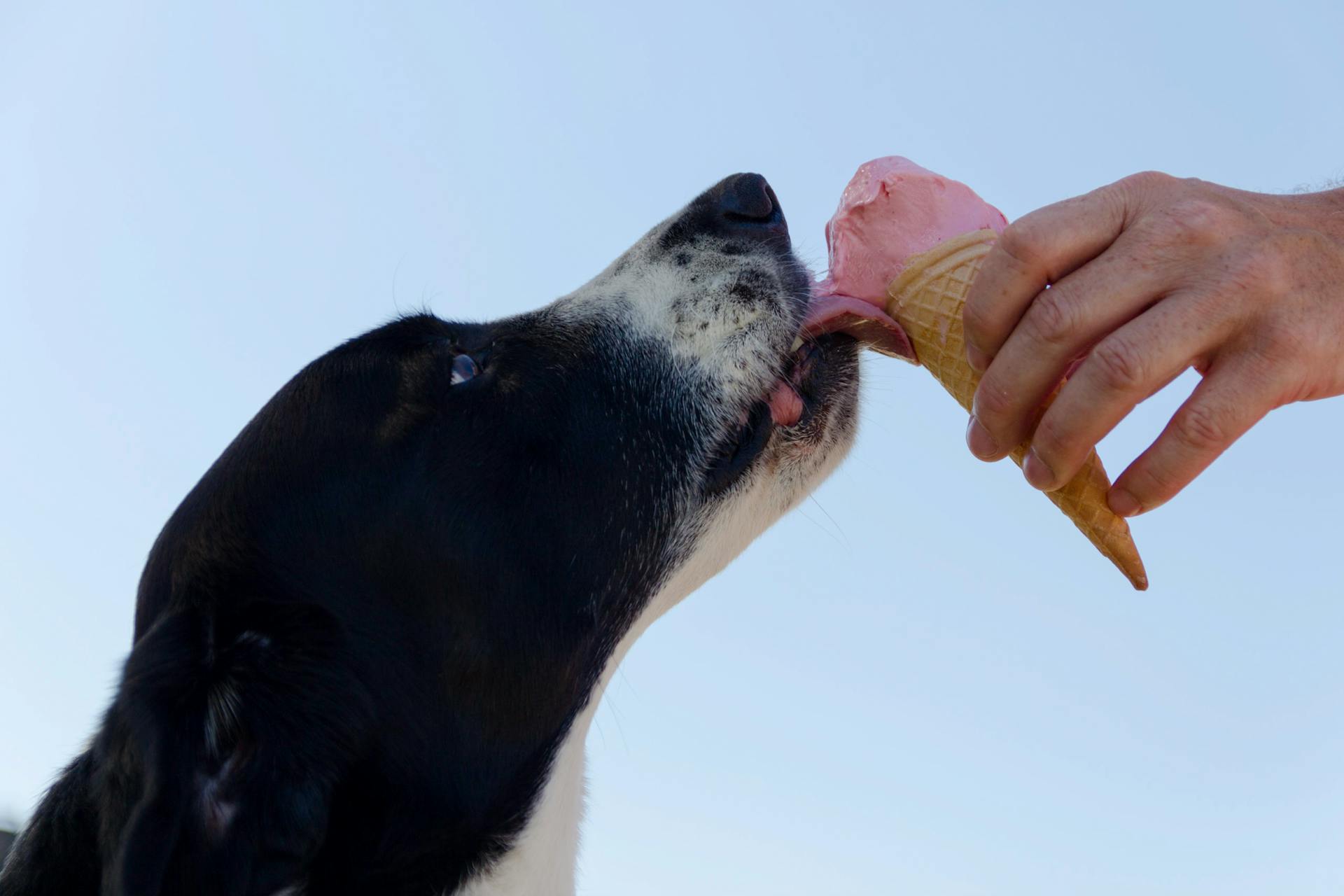
Dogs can develop Pica eating disorder, a condition where they eat non-food items, such as dirt, rocks, or paper.
Pica is a relatively common behavior in dogs, affecting up to 25% of dogs in some studies.
Some common items that dogs with Pica might eat include soil, chalk, or even cat litter.
In most cases, Pica eating disorder is a sign of an underlying issue, such as a nutritional deficiency or a medical condition.
Dogs with Pica may also be experiencing anxiety or stress, which can lead them to seek comfort in eating non-food items.
Pica can be a challenging condition to diagnose, as the symptoms can be subtle and may not be immediately apparent.
Check this out: Senior Dogs Eat Puppy Food
What Is Pica?
Pica is a complex disorder characterized by a persistent and unexplained craving for non-food items or substances.
Dogs can develop pica, just like humans, and it's not uncommon in certain breeds or situations.
Pica can manifest in various ways, including eating dirt, rocks, or even paper products.
The exact cause of pica is unknown, but it's often linked to nutritional deficiencies, stress, or anxiety.
Some common signs of pica in dogs include excessive drooling, vomiting, or diarrhea after eating non-food items.
Dogs with pica may also exhibit abnormal behaviors, such as digging or pawing at the ground.
Causes and Risk Factors
Pica in dogs can be caused by boredom and lack of mental stimulation, leading them to engage in self-amusement by eating non-food items.
Attention-seeking behavior is another possible cause, where dogs may display pica to draw the interest of their owners and receive a reaction.
Dogs experiencing anxiety, stress, or emotional distress may turn to pica as a coping mechanism, providing a sense of comfort or relief from their emotional state.
Nutritional deficiencies can also contribute to pica, with certain vital minerals like iron, zinc, or fiber necessary for a well-balanced diet.
Severe pica is more commonly associated with underlying disease rather than anxiety or stress, and ingestion of non-food items creates an increased risk of GI obstruction, which is life-threatening.
Ingestion of larger amounts of non-food items on a frequent basis increases the risk of obstruction and is a serious concern for dog owners.
Pica can be triggered by several medical issues, including nutritional deficiencies, underlying health conditions like thyroid problems or diabetes, and general malnutrition.
Worth a look: How to Stop Dog from Eating Other Dogs Food
Geophagia
Geophagia is a form of pica where dogs ingest soil, dirt, or rocks. This behavior can be triggered by the flavor, texture, or minerals present in the soil or rocks.
Dogs may be drawn to the earthy flavor of soil or the crunch of rocks. Some dogs may even crave the minerals found in soil, such as calcium or iron.
Geophagia can be a sign of an underlying medical issue, so it's essential to consult with a veterinarian if you suspect your dog is exhibiting this behavior.
For another approach, see: Can Dogs Die from Eating Rocks
Behavioral Causes
Dogs that receive inadequate psychological and physical stimulation may engage in pica to lessen boredom or for self-amusement.
Some dogs may display pica to draw the interest of their owners, and if they get noticed or receive a reaction, it reinforces the behavior and motivates them to keep doing it.
Dogs experiencing anxiety, stress, or emotional distress may turn to pica as a coping mechanism.

Nutritional deficiencies can contribute to pica in dogs, with certain vital minerals like iron, zinc, or fiber being necessary for a well-balanced diet.
Dogs that lack physical and mental stimulation tend to be more likely to develop pica, as they try to distract from their loneliness.
A thorough behavioral evaluation is essential in diagnosing pica, which may involve assessing a dog's living conditions, social contact, and recent changes that may have contributed to the behavior.
Separation anxiety, a normal emotion that causes fear, distress, and increased alertness, can lead to pica in dogs that are left alone for long periods.
Dogs that get adequate daily physical and mental exercises tend to be healthy and less likely to develop pica, which is often a result of negative behaviors like eating non-food items.
Potential Medical Causes
Pica in dogs can be triggered by several medical issues, including nutritional deficiencies that lead dogs to ingest non-food items in an attempt to replenish lacking nutrients.

Nutritional deficiencies can cause dogs to crave eating non-food objects in search of deficient minerals and vitamins.
Underlying health conditions such as thyroid problems, diabetes, and general malnutrition also contribute to this behavior.
Dogs with gastrointestinal conditions or malabsorption problems may exhibit pica, as these diseases can interrupt the proper digestion and engrossing of nutrients.
Hormonal imbalances, such as those associated with thyroid or adrenal gland disorders, can alter appetite management and result in aberrant eating behaviors, including pica.
Dogs with diabetes may develop abnormal appetite levels, causing them to eat even non-food items.
In some cases, dogs may learn pica by observing and imitating the behavior of other dogs or even their human companions.
Broaden your view: Dubia Roaches Eat Dog Food
Pica in Puppies vs Adults
Pica in puppies is often a normal part of their exploratory phase as they learn about their environment.
Puppies tend to chew on items as they figure things out, which can sometimes be mitigated by providing suitable toys and supervising their play.
In contrast, adult dogs displaying pica more frequently signal underlying health issues.
Pica in adult dogs can be a sign of nutritional deficiencies or psychological stress.
Adult dogs require a more thorough veterinary examination to rule out serious conditions and to implement appropriate dietary changes or behavioral therapies.
Symptoms and Diagnosis
Symptoms of Pica in dogs can be quite varied and may include gastrointestinal irritation, such as diarrhea, vomiting, and chronic bad breath. These symptoms can be caused by the ingestion of a foreign object.
If the ingested object blocks the respiratory tract, your dog might cough or sneeze frequently. In severe cases, Pica can result in infection or poisoning.
Here are some common symptoms of Pica in dogs:
- Diarrhea
- Vomiting
- Chronic bad breath
- Lethargy
- Lack of appetite
- Coughing or sneezing
- Stomach pain
- Blood in stool
- Constipation and other bowel problems
- Consistent stomach upsets
- Inability to defecate
- Dirty or contaminated feces
- Constant choking
- Drooling
- Bad breath
- Vomiting
Diagnosing Pica can be challenging, but your veterinarian may perform bloodwork, urinalysis, and test samples of your dog's stool to check for underlying medical issues. They may also perform X-rays or ultrasounds to check for GI obstructions.
Pagophagia
Pagophagia is a condition where people or animals eat ice or other frozen objects. Some dogs with iron deficiency may exhibit this type of pica. It's a sign that the body is craving something, in this case, iron.
Wool-Sucking
Wool-sucking is a form of pica where dogs develop a fascination with chewing or swallowing fabrics like blankets or garments.
This behavior is often linked to nutritional deficiencies, as seen in the case of fabric-eating pica.
Dogs may start wool-sucking due to a lack of essential nutrients in their diet.
Some common signs of wool-sucking include finding chewed-up fabrics or seeing your dog gulping or swallowing them.
Nutritional deficiencies can be caused by a variety of factors, including a poor-quality diet or inadequate nutrient absorption.
If you suspect your dog is engaging in wool-sucking, it's essential to consult with a veterinarian to rule out any underlying health issues.
See what others are reading: Dogs Eat Nutritional Yeast
Symptoms
Symptoms of pica in dogs can be quite varied and may depend on the type of item consumed. Dogs with pica may exhibit gastrointestinal irritation, including diarrhea, vomiting, and chronic bad breath.
If the ingested item is blocking the respiratory tract, your dog might cough or sneeze frequently. In severe cases, pica can result in infection or poisoning.
Some common symptoms of pica in dogs include stomach pain, blood in stool, constipation, and bowel problems. Your dog may also experience consistent stomach upsets, sneezing or coughing, and inability to defecate.

Other symptoms can be caused by bacterial, toxic, or poisonous content from the non-food items consumed. These symptoms may include injuries to the dog's teeth, lead poisoning, and frequent intestinal blockages.
Here are some key symptoms to look out for:
- Stomach pain
- Blood in stool
- Constipation and bowel problems
- Consistent stomach upsets
- Sneezing or coughing
- Inability to defecate
- Dirty or contaminated feces
- Constant choking
- Drooling
- Bad breath
- Vomiting
It's essential to note that pica can lead to an intestinal obstruction, which is an emergency. If you suspect your dog has ingested harmful objects, contact your veterinarian immediately.
Stimulation
Dogs that receive inadequate psychological and physical stimulation may engage in pica to lessen boredom or for self-amusement. This can happen when they don't get enough exercise or mental stimulation.
Providing plenty of mental and physical exercise can help avoid boredom, which can lead to pica. Dogs that get adequate daily physical and mental exercises tend to be healthy and act more quietly at home.
Playing with your dog regularly can help them learn motor skills, prepare for unexpected situations, and build social cohesion. Dogs that lack physical and mental stimulation distract themselves by engaging in abnormal behaviors such as eating non-food items.

Interactive play sessions and puzzle toy activities can stimulate your dog's mind and provide a sense of comfort or relief from anxiety or stress. Dogs experiencing anxiety, stress, or emotional distress may turn to pica as a coping mechanism.
Puzzle toys can be a great way to keep your dog engaged and stimulated, especially when you're not around to play with them. Dogs that are left alone with little or no play are more likely to develop pica as they try to distract from their loneliness.
Discover more: Can Dogs Play after Eating
Treatment and Prevention
Treatment for pica in dogs depends on the underlying cause, which can range from medical issues to psychological problems. If caused by an underlying medical issue, treatment for that specific health condition may be enough to stop the behavior.
Nutritional deficiencies can be addressed through dietary changes, nutritional supplements, or changes in feeding schedules. Your vet may recommend these adjustments to help your dog break the habit of eating non-food objects.
Preventing pica in dogs is often easier than treating it. Keeping your dog's environment free from non-food objects and providing enough mental and physical stimulation can go a long way in preventing the behavior.
Pet's Medication
Your dog's medication can sometimes cause pica as a side effect. This is especially true for pets taking anti-seizure or corticosteroid medications.
These types of medications can irritate the digestive system, leading to vomiting, nausea, and constipation. Your dog might turn to eating non-food objects to compensate for the food they've lost during diarrhea and vomiting.
Prolonged use of these medications can cause pica as your dog's appetite will be at abnormal levels. Regular vet check-ups are vital to identify the underlying causes and appropriate treatment for pica.
Consult your vet if you suspect your dog's medication is contributing to pica. They can help you adjust your dog's diet and treatment plan to mitigate these side effects.
Additional reading: Can Eating Grass Cause Diarrhea in Dogs
Prevention and Management
Preventing pica in dogs is crucial, and it starts with keeping them away from non-food objects.
To prevent pica, keep your dog on a leash while outdoors to prevent them from eating wood, rocks, or grass.

Ensuring your pup gets enough mental and physical stimulation is also key. This can be achieved by taking them for long walks, playing with them, and socializing them with other dogs.
A balanced diet tailored to your dog's specific needs can help mitigate pica. Nutritional assessments by veterinarians are vital for dogs displaying such behaviors.
Supervising your dog closely, especially during times when pica behavior is likely to occur, is essential. Use distraction techniques, such as redirecting their attention to toys or engaging in interactive play, to divert their focus from non-food items.
Puppyproofing your home is vital to prevent pica. This includes removing any hazardous objects that your dog might ingest.
Regular vet check-ups are vital to identify the underlying causes of pica and develop an effective treatment plan.
Frequently Asked Questions
What to feed my dog with pica?
For dogs with pica, consider a high-fiber diet or weight-loss foods to help manage the condition. Your veterinarian can also recommend prescription medications to address anxiety-related pica.
Featured Images: pexels.com


